
Christmas Holidays at Sea: 1 2 3 4 5 6 Next>>
Christmas Holidays at Sea in the Golden Age of Piracy, Page 1
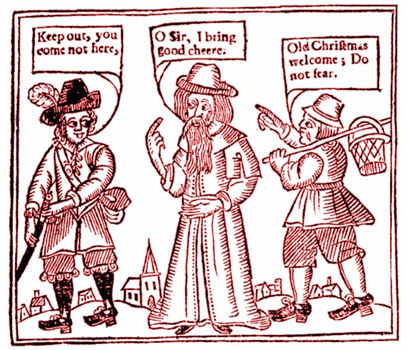
Defending Father Christmas, a Man Who Appears No Where Else in This Article.
From The Vindication of Christmas, By John Taylor, Frontispiece (1652)
"[1676] Having put all our goods [from the merchant vessel Mayflower] on shore that we were to deliver [to Marseilles], we walked ashore being Christmas, to take our recreation and see all about the town, which is a place of very good buildings and a pretty large town or city, where all things are very plentiful, both for meat and drink. They have a very good wine of several sorts and very cheap, especially a red wine, which is a king of wine much like to claret, only a clearer red and better wine to drink." (Edward Barlow, Barlow’s Journal of his Life at Sea in King’s Ships, East and West Indiamen & Other Merchantman From 1659 to 1703, p. 271)
Christmas is a holiday of long tradition and ceremony, so much that it was recognized as such and often celebrated at sea, although not quite on the scale and commercial scope with which we celebrate it today.
It typically involved a day off when it could be had, combined with feasting in the best manner as could be assembled while the vessel was away from land. Let's look at how the sailors, buccaneers, privateers and pirates celebrated this holiday.
Christmas with the Sailors and Clergy
Christmas in the English society of this period was a religious observance at its core. As a result, the clergy had an important role in the Christmas celebration found in the account sof the navy... and even among some pirates.
Navy chaplain Henry Teonge mentions Christmas several times in his diary, which befits his role. Teonge entered the seaman's life at the rather rather advanced age of 55. He made two trips with the Royal Navy, the first 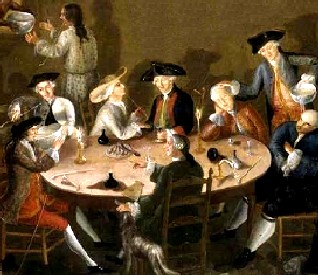
Artist: John Greenwood
Sea Captains Carousing in Surinam (1750s)
aboard the Assistance from 1675-1676 and the second on the Bristol from 1678-1679, each of which were 48 gun fourth rate naval ships.1 He vividly details his first Christmas at sea on December 25th 1675, beginning with the sacred aspects of the celebration and ending with the more profane.
Chrismas day wee keepe thus. At 4 in the morning our trumpeters all doe flatt their trumpetts, and begin at our Captain's cabin, and thence to all the officers' and gentlemen's cabins; playing a levite at each cabine doore, and bidding good morrow, wishing a merry Chrismas. After they goe to their station, viz. on the poope, and sound 3 levitts in honour of the morning.
At 10 wee goe to prayers and sermon; text, Zacc. ix. 9. Our Captaine had all his officers and gentlemen to dinner with him, where wee had excellent good fayre: a ribb of beife, plumb-puddings, minct pyes [mince pies], &c. and plenty of good wines of severall sorts; dranke healths to the King, to our wives and friends; and ended the day with much civill myrth.2
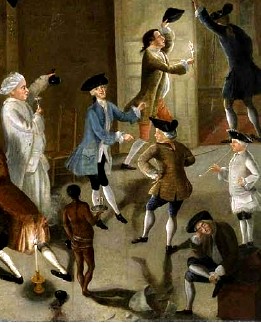
Artist: John Greenwood
Dancing Sea Captains Carousing in Surinam
(1750s)
Teonge's second Christmas at sea in 1678 was not quite so fine, he noting that during the Christmas day prayers, "the wind roase of such a sudden, that I was forced (by the Captain's command) to conclude abruptly at the end of the Letany [litany]; and wee had no sermon."3 He opined that they "had not so greate a dinner as was intended, for the whole fleete being in this harbour, beife could not be gott"4. This hints the preeminence of meat, and particularly beef, in the sailor's diet. Still, he goes on to lovingly detail what was served:
...an excellent rice pudding in a greate charger, a speciall peice of Martinmas English beife, and a neat's tounge, and good cabbige, a charger full of excellent fresh fish fryde, a douzen of wood-cocks in a pye, which cost I5d., a couple of good henns roasted, 3 sorts of cheese ; and last of all, a greate charger full of blew figgs, almonds, and raysings [raisins]; and wine and punch gallore, and a douzen of English pippens [apples]."5
Another fascinating account of holiday feasting during the Christmas season from Teonge takes place on the twelfth day of Christmas in 1676.
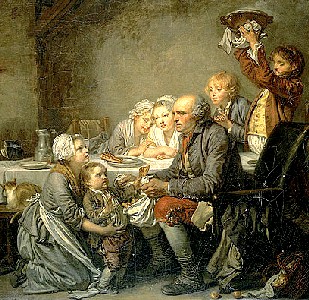
Image: Jean-Baptiste Grueze
Serving a King Cake from Le Gateau des Rois (1774)
...wee had much myrth on board, for wee had a greate kake made, in which was put a beane for the king, a pease [pea] for the queen, a cloave for the knave, a forked stick for the coockold, a ragg for the slutt. The kake was cutt into severall peices in the great cabin, and all putt into a napkin, out of which every on took his peice, as out of a lottery, then each peice is broaken to see what was in it, which caused much laughter, to see our leiuetenant prove the coockold, and more to see us tumble on over the other in the cabin, by reason of the ruff weather.6
Teonge is here describing a King Cake, which is used to celebrate the Epiphany of Jesus on January 6th. ('King' referring to the three wise men or three kings of biblical lore.) Traditionally, a bean was hidden in it, a custom borrowed from the Saturnalia of the Roman Empire. The person who got it in their piece of cake was referred to as the 'king of the feast.'7 This tradition was elaborated upon in Teonge's account, with the addition of several other items and associated characters, some of whom appear to be more appropriate to the sailors.
You might at this point protest that while the Navy might have clergymen on their ships, the pirates would not; believing, as Captain Charles Johnson stated in his General History of the Pirates that they were men "who fear neither God or Devil, as this [Captain John] Phillips us'd often blasphemously to express himself."8 However, much of the English pirate's ire with the clergy had more to do with their country having been enemies with Spain and a dislike of "papists." From the French, who were often Catholic, we have this extraordinary account of the pirate Daniel given by Pere Jean-Baptiste Labat in his account.
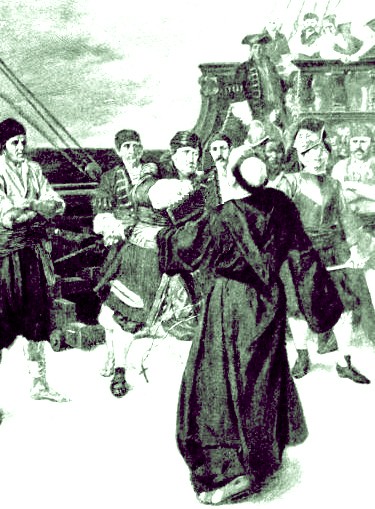
Image: J. N. Marchand
The Padre and the Pirates, from Sir Henry Morgan Buccaneer
by Cyrus Townsend Brady, p. 139 (1903)
...the pirates asked the curé to say Mass on their barque, and he was unable to refuse this request. They sent for the church ornaments, and put up and alter on the poop under an awning, and then chanted Mass lustily.
A salvo of eight cannons marked the commencement of the service, they fired a second salvo at the Sanctus, and third at the Elevation, a fourth at the Benediction, and lastly a fifth after the Exaudiat, while the prayer for the King was followed by the most hearty 'Vive le Roi'.
Only one incident slightly marred this ceremony. One of the pirates adopted an offensive attitude during the Elevation, and on being rebuked by the captain, he replied insolently with a horrible oath. [French pirate Captain] Daniel promptly drew his pistol and shot him through the head and swore by God that he would do the same to anyone else who showed disrespect to the 'Sainte Sacrifice'.9
So whether pirates embraced clergymen from their country or not is more complex that it might first appear. What is more unlikely about Teonge's account when describing the pirate's method of celebrating Christmas is that it primarily details what the officers would have done during the holiday.
The officers on a naval ship were typically well provided for and had better food and drink than the average seaman. Pirates usually had a much flatter organization where even the pirate captain had limited powers. According to one account, each man had the ability to "be Captain over him [the captain, where] every Man, as the Humour takes him, will use the Plate and China [allotted to the captain], intrude into his Apartment, swear at him, seize a Part of his Victuals and Drink, if they like it, without his offering to find Fault or contest it"10. So from that perspective, the Christmas celebrations of ordinary seaman may provide a more accurate window into how the pirates celebrated Christmas.
1 Henry Teonge, wikipedia.com, gathered 11/23/12; 2 Henry Teonge, The Diary of Henry Teonge, Chaplain on Board H.M.’s Ships Assistance, Bristol, and Royal Oak, 1675-1679, p. 127-8; 3 Teonge, p.269; 4 Teonge, p.269-70; 5 Teonge, p.270; 6 Teonge, p.130-1; 7 King cake, wikipedia, gathered 11/22/12; 8 Captain Charles Johnson, The General History of the Most Notorious Pirates, p. 401; 9 Pere Jean-Baptiste Labat, The Memoirs of Pére Labat 1693-1705, p. 221-2; 10 Johnson, p. 234

